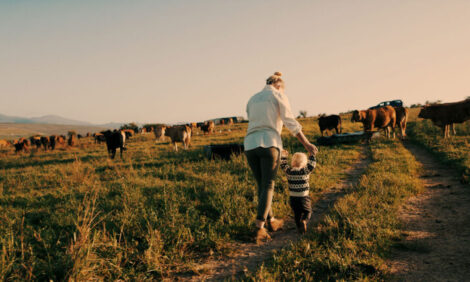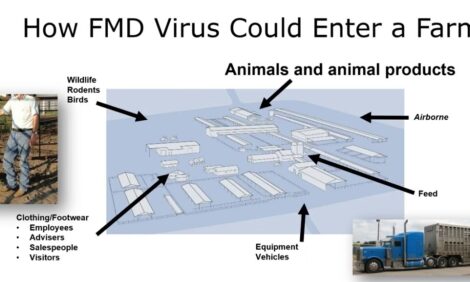



Retained Ownership
Retained ownership gives producers the opportunity to realise the full potential of their animals. Holding cattle back longer can lead to greater gains for producers, however there is a lot to consider, writes TheCattleSite junior editor, Charlotte Johnston.Retained ownership is holding cattle longer than would normally be the case or to the next one or two stages of production, explains Stephen Blezinger, a nutritional and management consultant in Texas. An example of this would be when a producer who normally sells a calf crop at weaning, holds onto them through a grazing/ growing period, or when a producer grows cattle out to a larger weight or until finishing by feeding in a feedyard.
Retained ownership practices include everything from the use of pastures and crop residues to dry lot feeding and many combinations of those alternatives, says Mr Blezinger.
Having the option of retaining cattle, means the producer can hold out until prices improve or use up extra feed they have on the holding. Jose Pena, AgriLife Extension economist says it is a way of adding value to animals. With the US cattle inventory declining year on year, Mr Pena reports that cattle marketings are down 4.1 per cent from a year ago to the lowest fed cattle marketing's since the series began in 1996. This is expected to push prices up making retained ownership an opportunity to add value to calves.
Increased Marketing Flexibility and Risks
Retaining calfs means that the producer has full control of when, what and where cattle are sold. Mr Pena says that it is important producers recognise cyclical patterns for feed and cattle supplies and prices.
Producers have the option to sell as feeder cattle (anything up to 900lbs) or as fed cattle. Some producers may find it difficult to attract buyers to a small farm, however there is the option of feeding in a commercial feedyard - where a number of buyers will visit.
There is a major price risk to be considered when retaining ownership. says Mr Blezinger. The price risk for cattle could be related to a change in the general price level, to changes in animal quality (such as more fat) and change related to weight. Mr Blezinger stresses that heavier cattle often receive a lower price than lighter cattle.
Mr Pena says that retained ownership will require careful planning, monitoring and a review of alternatives in order to minimise the risk. The market risk for retained ownership is reduced this year as prices for feeder cattle and feed are lower, believes John Nalivka, president of Sterling Marketing.
Producers must carefully consider prices and trends and try to plan as well as possible by forecasting a buy/sell margin. This is the difference between the purchase price in the fall for the calf and the sale price for the yearling in the spring. Producers must then ascertain costs of production as best they can to know whether or not retained ownership will be a profitable business.
John Lawrence, Iowa Extension livestock economist suggests selling cattle throughout the year (at weaning, some as feeders and some as fed cattle) spreads the risk and marketing over time. He says that packers often offer cash forward contracts on fed cattle, which is less common on feeder cattle.
Feeding at Home or in a Commercial Feedyard?
Before deciding where the calves will be fed the producer must establish what resources are available with regard to feed, labour, facilities and skills and how they are best utilised, says Mr Lawrence.
Feeding calves at home uses resources which are already there such as labour, forages and facilities etc. says Mr Blezinger. However, Mr Lawrence warns that feeding at home may not produce as efficient gains as those of commercial feedyards.
Feeding cattle in a commercial feedyard allows the cow owner to hire specialists and up-to-date facilities. Often feedyards have consulting nutritionists, marketing and risk management specialists as well as other professionals. Feeding through a feedyard could provide greater access to lower feed costs such as alternative feedstuffs or a wider corn basis.
Often cattle producers may not have enough calves of similar kind at one time to use retained ownership strategy. Commercial feedyards can combine cattle from different owners in the same pen and can divide the feed bill according to the animal's size and average daily gain using the net energy system.
Cashflow and Tax Implications
Cashflow requirements may be complicated for the first year that a producer retains ownerships, warns Mr Lawrence. Without having the income from selling calves in the fall, the producer must purchase extra feed to meet requirements. This may mean that debts are unpaid for several months. If applying for a loan, ensure that lenders are aware of the plans and see the benefit of retained ownership. Financing packages offered by feedyards that free up part of the value of the calf and finance the feed can greatly ease cash flow binds.
With regard to income tax management, switching from retaining calves and selling them in the same tax year may create problems. Two calf crops in one year may mean more income tax is due.
Additional Advantages
Retained ownership in commercial cattle gives producers an opportunity to improve profitability. Purebred breeders can use retained ownership as an outlet for cattle in the herd which do not meet replacement breeding standards and can improve the profitability of these animals in the correct circumstances.
Mr Lawrence believes that calves will suffer less stress through retained ownership and retain more weight than if they had gone to auction immediately after been weaned, and then on to feedlots. He says that producers can benefit from a sound health programme without the costly duplication of vaccination if there is communication with the feedyard on processing protocol.
In conclusion, before embarking on retained ownership, be sure that all risks are considered and that the opportunity exists. Beware that the profitability of retained ownership will vary year on year. Mr Lawrence says that successful cow owners will be those who can adjust their programme to changes in market conditions in order to achieve the greatest returns to their resources.
October 2009


